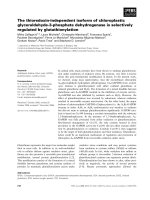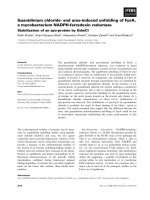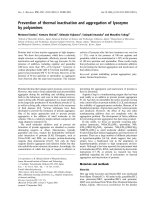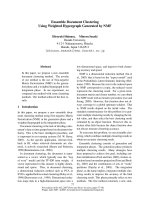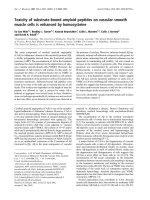Paint by Grids docx
Bạn đang xem bản rút gọn của tài liệu. Xem và tải ngay bản đầy đủ của tài liệu tại đây (131.47 KB, 7 trang )
Paint by Grids
A Great Sketch Results in a Great Painting
How to use the Grid Method to Achieve Accurate Shape and Perspective in
Art
Failure to achieve accurate shape and
perspective in a finished work of art is
why many of us give-up and declare
ourselves "non-artists." There's nothing
worse for a student's artistic self-
confidence than having a painting of a
horse turn-out looking more like a dog.
Yet there is a simple method of
ensuring that the finished work will
have proper shape and perspective.
Artists dating back to the ancient
Egyptians knew of a technique to break
down a painting into smaller "grids" to effectively divide the image they
were painting into a number of smaller images, each of which has less detail
than the whole. The "grid method" was even used by Leonardo Da Vinci in
both his works and in teaching. Today the grid method is alive and well in
many art schools, but the math that's required deters many would-be artists.
Basically, the grid method is nothing more than overlaying a grid onto an
original image that you wish to paint, and then placing a matching grid
pattern on your canvas. For example, if your original image is an 8" x 10"
photograph, you could draw a one-inch
grid onto the photograph to create a grid
pattern with eighty squares (eight
squares by ten squares). The original
photograph or image is now divided
nicely into eighty bite-sized pieces,
each of which are much easier to sketch
onto the canvas than the entire original
(Fig. 1).
Gridding results in better artwork because each of the smaller squares gets
sketched one at a time until the entire sketch is finished. Once the sketch is
done, the student can then begin to paint, mixing paints as usual. But if the
sketch isn't done well, the finished painting will be disappointing. Gridding
allows the underlying sketch to almost perfectly match the original, which
will result in a satisfying painting with perfect proportions and perspective.
Clearly this method is useful only when there is an original image to paint.
An imagined scene or abstract concept is difficult to grid, obviously, since
the artist is not working from an original image or photograph. But most
beginning artists and certainly art students learn by painting from an
original photo, and the gridding method is an amazing aid in this regard.
Once the grid has been placed on the original image, the next step is to draw
a corresponding grid pattern on the canvas. If your canvas is the same size as
your image, then the grid that you draw onto the canvas is just the same size
grid that you created on the original photograph. However, if in our example
we're using, say, a 16" x 20" canvas, then we need to do some simple
algebra to get 80 squares onto this canvas. Taking the longest side first,
divide the canvas size by the number of squares along that side on the
original image to get the distance between grid lines. In our example, 20"
divided by 10 squares = 2" per square (Fig. 2).
This may be the right distance to use between gridlines on the shorter side as
well, but we'll have to do the same calculation first to see if a 2" grid pattern
will fit along the shorter side. Remember, in our example we have to get at
least eight squares along this shorter side. Let's see if it works. Divide 16"
(the shorter side of the canvas) by 2" and you get eight. So a 2" grid pattern
will fit perfectly on a 16" x 20" canvas when your original image is 8" x 10".
This works perfectly because the aspect ratio of both the image and the
canvas are the same. The aspect ratio is the short side divided by the long
side, or in our examples 8/10 = 16/20 = 0.8. Obviously you could paint a 24"
x 30" or a 32" x 40" canvas using 3" and 4" grid lines, respectively, and still
have the math work-out. Again, this is because the aspect ratios of the
shorter side to the longer side in each of these canvas sizes is 0.8.
Now it gets a little trickier when the aspect ratio (or shape) of your canvas is
different than the aspect ratio of your original image. For example, if we're
using the same 8" x 10" original but now we're going to paint a nice, large
30" x 40" canvas, you can see that the aspect ratio of the original, 0.8, does
not equal the aspect ratio of the canvas, which is 30"/40" = 0.75. Now what?
We still would like to squeeze an 8 x 10 grid pattern within the 30" x 40"
canvas, but we'll have some "left over" space at either the top or bottom.
Since we've already gridded our photograph, changing the aspect ratio of the
photo is not an option. (There are tools that allow you to "re-grid" your
original; more information on these tools is below.)
Let's assume that our original image is in "landscape" orientation, where the
longer sides are the top and bottom. Now the question is how do we best
grid this 30" x 40" canvas so that the composition is relatively unchanged
from the original image?
First, let's see which sides we'll have to squeeze the most. Dividing the
longer40" side by 10 gives us an even 4" grid size. Dividing the shorter 30"
side by 8 gives us 3.75". Thus we have to limit the grid pattern to 3.75" if
we're going to squeeze an 8 x 10 grid pattern completely into a 30" x 40"
canvas. So if we are limited to 3.75" along the longer dimension, 10 squares
at 3.75" per square will yield 37.5". Subtracting 37.5" from 40" results in
2.5" of "left over" space, which we'll want to evenly divide between either
side. So the 8 x 10 grid pattern in our example will fit snuggly into a 30" x
40" canvas with 1.25" of left over (or non-gridded) space on both the left
and right sides (Fig. 3). It also helps to label the columns and rows of your
grids with numbers and letters.
Now that we know how to grid our original image and canvas, it's time to
sketch. The gridding method is excellent for teaching the concept "paint
what you see, not what you think." Often the mind fools the eye into seeing
something that's not there, and the painting suffers as a result. The grids
allow the eye to see only what's in each square, and effectively blocks out
the rest of the painting. It is often helpful, in fact, to cut out a single square
in a piece of dark paper to place over the original image to physically block-
out the other squares. This helps train the "artist's eye" in the student, an
important skill as the student advances (Fig. 4).
When the sketch is finished, the student carefully erases the grid lines on the
canvas, and may then begin to paint. At this point, regardless of the color
selection, stroke, or type of paint, the resulting image will be in perfect
shape and perspective as long as the student paints within the lines of the
sketch. The result is a very satisfying painting.



